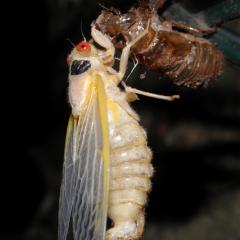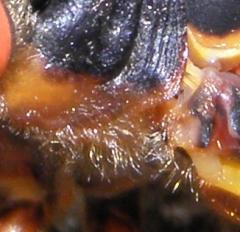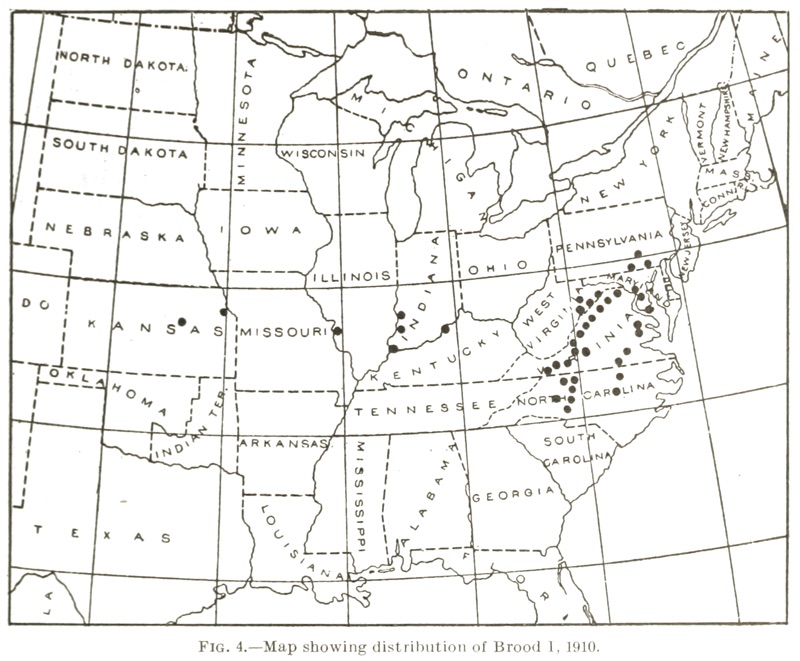Brood I will next emerge in 2029. Stragglers may emerge four years early in 2025.
When will they emerge?
Typically, once the soil 8 inches (20cm) below the surface gets to 64 degrees Fahrenheit (18 degrees Celsius) they will emerge. Cicadas in sunny areas will emerge before cicadas in shady areas. Mid-April to mid-May.
Where will they emerge?
Historically, Brood I has emerged in counties along the border of Virginia and West Virginia, including the counties: Augusta, Bath, Bedford, Botetourt, Grant, Page, Pendleton, Rockbridge, and Rockingham. There is another group that emerges on the border of Tennessee and Virginia. Visit the Cicadas @ UCONN website for an updated map of Brood I.
Important: Magicicadas won’t emerge everywhere in the counties mentioned above. They might not exist in your town or neighborhood (particularly if there’s lots of new construction, which removes trees). The key to seeing them if they don’t emerge in your neighborhood is communication: networking with friends and family, checking the interactive maps on magicicada.org, checking sites like Twitter, Facebook and YouTube.
What you should look for
Look out for cicada chimneys, turrets or holes the diameter of an adult’s finger near the root system of a tree. These are sure signs that cicadas will emerge in the area.
You might discover some cicada nymphs while turning over stones or when performing landscaping chores. They are a golden-brown color, with black coloration in the area behind their heads.
Here is a great video of Magicicada nymphs once they have emerged from the ground:
Magicicada cicada nymph mania from Cicada Mania on Vimeo.
Once cicadas nymphs have emerged from the ground, they will try to find a tree, and then begin the process of exiting their old nymph skins, drying their wings, and changing to their adult coloring. If you have the time, a flashlight and a camera you can record this amazing transformation.

What are they?
Magicicada is a genus of periodical cicadas known for emerging in massive numbers in 17 or 13 year cycles/periods. The cicadas emerging in 2012 have 17 year life-cycles. Magicicada are also organized into broods. There are 12 broods of 17 year cicadas, and the brood emerging in 2012 is Brood I (Brood One).
There are 3 species of 17-year Magicicada: M. septendecim (aka “decims”), M. cassini, and M. septendecula. The adults of all three species have black bodies with orange markings and red-orange eyes.
Perhaps the best way to visually distinguish the adults of the three species is by observing the coloration on their abdomens: M. septendecim have broad orange stripes with more orange than black; M. cassini has black abdomens with virtually no stripes at all, and M. septendecula has stripes that feature as much black as orange. Visit this Cicadas @ UCONN species page for detailed information, including photos and audio.
M. septendecim also have an area of orange coloring between the eye and the wing: 
Another great what to tell their difference is to listen to their song.
- M. septendecim calling. Sounds like “Pharaoh, Pharaoh!”
- M. cassini calling. Note how it makes quick burst of sound, followed by some rapid clicks.
- M. septendecula calling. Note the “tick, tick, tick, tick” steady rhythm of its call.
Here is some video and audio of 17 year Magicicada. This will give you an idea of what to expect:
Cicada Mania, best of 2007, part 1 by Dan from Cicada Mania on Vimeo.
Note: some folks call these cicadas “locusts”, but they are not true locusts.
Why?
Why do Magicicadas wait 17 years and why do they emerge in such large numbers? There are many theories why, but the primary reason could be that they’re trying to beat the predators. Since they emerge only once every 17 years, no species can anticipate their emergence (except man), and emerging in large numbers ensures that at least some of them will survive to reproduce. See more about Cicadas and Prime Numbers.
Who?
People have many reactions to Magicicada including fear, disgust, panic, mild curiosity, fascination, and fanaticism. We hope that YOU will find them fascinating, and get involved by helping to map the emergence, upload your cicada photos and videos to sites like YouTube, Pinterest, and Flickr, and participate in discussions on Twitter and discussion forums like Reddit.
More information:
1907 Map from Marlatt, C.L.. 1907. The periodical cicada. Washington, D.C. : U.S. Dept. of Agriculture, Bureau of Entomology.


14 replies on “A Brood I Magicicada Periodical Cicada Primer for the 2012 Emergence”
I have seen lots of red eyes with a yellow wing stripe this week after huge noise last week. They are singing lightly tonight after days of quiet. This is in Freelton north of Hamilton Ontario, Canada.
Are they the same ones still singing and mostly when it is hot?
Thanks
I keep finding dead cicada’s all over town in Harrisburg PA area.
That’s great. At this point of the year, they are probably Tibicen cicadas, not Magicicadas. You’ll find the main differences on this page https://www.cicadamania.com/cicadas/what-is-a-cicada/
I live in Poughkeepsie, NY 12601. I first experienced Cicadas here about 1961. I recently saw a newly molted skin attached to my house in a place where it could not have been transported to or been for more than a few days. As I research I see the type 2 breed is local to this area but not predicted to appear until next year. So are they early or ??? 8/9/2012 Chris
Chris, the cicadas you’ll see or hear at this time of the year are most likely Tibcen cicadas — a different type of cicadas than the 17 year variety.
They are chiming away in central New Jersey under a full moon! I feel so lucky, 17 years later, to hear them sing again.
I saw a dead one lying on my driveway – at first I thought it was a hummingbird. I live in Chester NJ and don’t typically see them unless it’s an “on” year
I’ve seen two different colored ones the last 4 days ob my porch in Flint,Mi
I live in northern NJ, in Newark. The other day a large insect flew in through my window. At first I thought it was a wasp, but then I realized from the size it was a cicada. This morning around 4am I saw another one. I recognize them because I was in Maryland in 2004 at the end of the last swarm. It is very hot here, so either they are emerging a year early, or they are the northern contingent from this brood year.
Michele, It’s likely an annual type of cicada, like a Tibicen.
I was near Harrisonburg, VA at the “Valley Fest” on May 26, 2012 and the cicadas were in full bloom. It was a sunny day on the top of Massanutten mountain and cicadas were landing on my shirt, hat and just about everywhere. The odd thing is they were confined to the mountain top, as soon as we came back down we didn’t see (or hear) them any more. I guess the lower elevations don’t have them because of all the recent construction which tore up the ground where they live.
There are tons of these things in Kingsport Tennessee right now. They were all over the Greenbelt when we went walking yesterday.
We’re in Washington County, VA about seven miles NE of Bristol. Our house is at the top of a hill surrounded by woods. We first noticed the chorus on May 9, 2012. We’re seeing lots of castings, nymphs and adults, especially in the shadiest parts of the woods. They are most vocal on sunny days. Today we’ve had rain off and on all day, and hardly any sound. I think we have more than one variety, based on my comparisons with your photos and description. We had young trees 17 years ago when the cicada emerged so we remember their last visit! This year, though, our trees are well established and so far so good. Will try to get some pictures for you. Thanks!!!!
I picked up a cicada tonight at Jacobs Creek Job Corps in NE Tennessee. I haven’t seen one since 1995 when I was in Virginia and at first didn’t even realize what kind of insect it was. I can honestly say, I wouldn’t eat one!